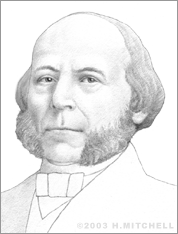John Ericsson
Swedish inventor John Ericsson, creator of the ship propeller, was born July 31, 1803 in Långbanshyttan, Wermelandia, Sweden. He was a born artist, gifted at the drawing board, and his talent in this area eventually led him to explore engineering. He and his brother, Nils, were highly intelligent and were noticed by colleagues of their father, Olof, when they were teenagers. They were asked to assist in designing a canal, a project for which Olof served as a director of blastings. By age 14, John was a topographical surveyor.
At age 17, Ericsson joined the Swedish army, where he quickly became a lieutenant. He continued to do surveying for the army and, in his spare time, designed a heat engine that used fumes from fire instead of steam as a propellent. He left the army and moved to England in 1826. His heat engine did not succeed, but he continued to work on engine-related mechanisms. He worked on a variety or projects, including new types of steam boilers, condensers for marine steam engines, a steam fire-engine, and a steam locomotive. He joined a competition with one of his steam train designs in 1829, but he did not win. He was losing money but remained undeterred.
Ericsson had been working on a ship propeller when American ship captain Robert Stockton became intrigued by his ideas and asked him to design a propeller steamer for him and to bring it to the United States. Ericsson did so and moved to New York in 1839. His propeller was successfully installed in the SS Princeton, completed in 1843. The vessel subsequently won a race against what had been regarded as the fastest steamer in the world, the SS Great Western, in the fall of that year.
In 1839, Ericsson’s propellers were introduced into vessels for inland waterways. That year, he also began working on building a large frigate for the U.S. Navy – the USS Monitor. This ship incorporated a steam-propelled screw propeller, low in the water. It also had a revolving gun turret and used iron construction rather than wood. The screw propeller is still the main form of marine propulsion. The Monitor was completed in 1862 and is credited with helping the Northern states stay protected during the Civil War.
Ericsson began working on the hot air engine in 1852. Though the engine never gained commercial success, he was awarded the Rumford medal for his achievement. He also worked with torpedo inventions, solar engines (which he called “sun engines” and were 100 years ahead of their time), and designs for ships and submarines. After working and living there for more than fifty years, he died in the United States in 1889.


